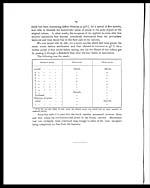Medicine - Institutions > Army health reports and medical documents > Scientific memoirs by officers of the Medical and Sanitary Departments of the Government of India > Number 21 - On the standardisation of anti-typhoid vaccine > On the standardisation of anti-typhoid vaccine
(21) Page 13
Download files
Individual page:
Thumbnail gallery: Grid view | List view

13
contains about 21/3 times the amount of immunising element that vaccine I
contains.
| 19th May 1905. | Experiment III. | Serum of goat VII. |
| Dilution of vaccine. | Vaccine I. | Vaccine II. |
| Undiluted | Growth. | Growth. |
| 2-fold dilution | ,, | ,, |
| 3 | ,, | ,, |
| 4 | Sterile. | ,, |
| 5 | ,, | ,, |
| 6 | ,, | ,, |
| 7 | ,, | ,, |
| 8 | ,, | ,, |
| 9 | ,, | Sterile. |
| 10 | Growth. | ,, |
The growth in tube 10 of vaccine I was evidently an experimental error.
It is, therefore, left out of account. It is clear that the serum in this observation
was much less bactericidal than in either of the two experiments previously
detailed. We can calculate, in the same way as we have done before, that
vaccine II is 2 ½5 times stronger as regards its immunising power than vaccine I.
When we compare the results of these three observations made with
the same two vaccines but with three different sera on three different days, we
find that the relative strengths, as regards receptor content, were practically
constant, namely, (1) 1: 2.2, (2) 1: 2.3,and (3) 1: 2.4; the average of the three
observations being 1:2.3 We can, therefore, take it that vaccine I as regards
its immunising power is 2.3 times weaker than vaccine II and that the dose
of the former should be 2.3 times greater than in the case of vaccine II. If the
dose of vaccine II be I cc., then we would expect the same immunising effect
from 2.3 cc. of vaccine I.
In conclusion, we have now to show that this method of comparative stan-
dardisation is also applicable to filtrate vaccines. Wright and Windsor12 have
already demonstrated that the filtrate of a broth culture of bacillus typhosus
Set display mode to: Large image | Zoom image | Transcription
Images and transcriptions on this page, including medium image downloads, may be used under the Creative Commons Attribution 4.0 International Licence unless otherwise stated. ![]()
| Permanent URL | https://digital.nls.uk/75028320 |
|---|
| Shelfmark | IP/QB.10 |
|---|---|
| Additional NLS resources: | |




